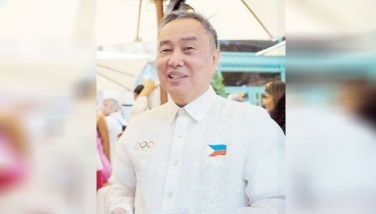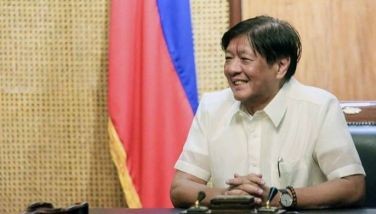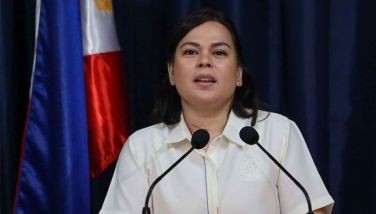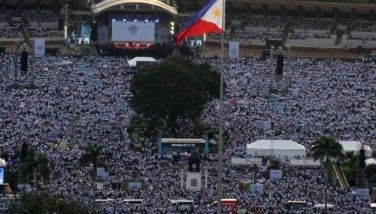Rice and fish

There was this story of a school girl whose baon every school day was a cup of rice sprinkled with patis or fish sauce. That was all her parents could afford, the story on social media said.
The basic Filipino diet is rice and fish. Fish and fish products provide the bulk of protein for more than half of all Filipinos when they eat.
Galunggong or scad was the poor man’s fish when I was growing up. But today, the poor can no longer afford galunggong. It is now imported.
Today, the most affordable fish are bangus and tilapia because these are products of aquaculture. Bangus and tilapia can be bought at P170 and P120 per kilo, respectively. That’s lower than local and imported galunggong, which range from P200 to P320 per kilo. Lazada lists it at P299.
“Per capita, Filipinos consume about 60 kilos of meat protein per year. Sixty percent of that or roughly 36 kilos comes from fish, according to government data. Hence, fish, like bangus and tilapia, can be a real ‘lifesaver,’ especially for low-income families,” Tugon Kabuhayan, an advocacy group said.
But like almost everything else, we have fumbled on bangus the way we have fumbled rice, corn, onions, garlic, etc. We used to be the market leader in bangus, with neighboring countries looking at us for technology assistance. Not anymore.
We are now importing our bangus fry from Indonesia and Taiwan. That’s because we did not continue investing in our breeder farms. The sabalo from Taiwan came from Palawan. They studied the breeding habits to produce fry.
Tilapia is now saving the day for many families. About 12 percent of their animal-based protein consumption comes from farmed tilapia.
We had so much promise in aquaculture. As late as 2018, the Food and Agriculture Organization (FAO) reported that the Philippines is the 11th largest aquaculture producer in the world, with a contribution of 1.01 percent of the total world production. The country is also the fourth largest producer of aquatic plants (including seaweed), comprising 1.48 million MT or 4.56 percent of the total world production.
A policy brief written by a team led by economist Dr. Karlo Adriano reports that the country’s aquaculture has a strong potential to expand and develop because of the availability of its vast resources (338,393 hectares of swampland, 14,531 hectares of freshwater fishponds, 239,323 hectares of brackish water fishponds, 200,000 hectares of lakes, 31,000 hectares of rivers, and 19,000 hectares of reservoirs).
“The proper management and utilization of these available production areas would easily increase aquaculture production by more than 100 percent,” the Adriano policy paper said.
But we have squandered our great potential in aquaculture, as in everything that the Department of Agriculture is responsible for. The local production of the sector has been stagnant since 2017. The average annual growth rate of aquaculture is only 0.1 percent from 2017 to 2021.
“Based on the data of the Philippine Statistics Authority (PSA), aquaculture production recorded an annual decline of -3.3 percent from 2,323 thousand MT in 2020 to 2,246 thousand MT in 2021, at constant 2018 prices. In terms of Gross Domestic Product (GDP), the fishery’s share is minimal with only a 1.5 percent average contribution from 2010 to 2020 at constant 2018 prices. Despite having a minimal contribution to GDP.”
While the global fisheries and aquatic production are rapidly growing, our aquaculture production is even contracting.
According to the Food and Fertilizer Technology Center (2008), Philippine aquaculture is faced with the following challenges: (1) Unavailability of high-quality fry/fingerlings, (2) High input costs, (3) Lack of post-harvest facilities, (4) Limited access to both local and international market, (5) Food safety and quality constraints, among others.
According to the policy paper, “the underdevelopment of the aquaculture sector can be attributed mainly to the lack of a value chain approach (upstream, production, midstream, and downstream).
“For instance, a major constraint in the upstream is the limited supply of fry or fingerlings and the high cost of inputs such as feeds and fertilizers.”
Studies have shown that the major upstream bottlenecks in the production of milkfish in the country are the high prices of commercial formulated feeds, and the insufficient local fry and/or fingerlings supply. On average, feeds constitute around 60 percent of the total operating costs of a typical pen or cage culture system.
“On the other hand, the country has been heavily dependent on the importation of fry to augment the fry requirements of the local milkfish industry… approximately 1.65 billion milkfish fry is required annually based on the country’s milkfish production. In general, this can be attributed to the insufficient investment in the development of hatcheries and nurseries.”
Aquaculture fishers are also faced with limited access to credit and financial assistance. How can they invest in new technology and modern facilities without access to credit?
The Philippines is also lagging behind other countries in terms of marketing and post-harvest practices for fishery products… According to ADB, the number of establishments processing aquaculture products that are HACCP-certified were still very limited… then there is the limited cold chain infrastructure…
Oh well… What else is new? We know what our problems are, our experts have good recommendations, but DA and BFAR flub implementation. We have good experts in aquaculture just as we have good experts in rice. If only decision makers listened to them.
I visited the Southeast Asian Fisheries Development Center, Aquaculture Department (SEAFDEC/AQD) in Iloilo some years ago with Senator Serge Osmena III. They do great work, which recently included farming galunggong.
“Our breeders have been spawning continuously since December last year until this February, and we now have thousands of galunggong in different larval to early juvenile stages at our hatchery, which we hope to further grow to market sizes to prove that we can farm galunggong,” revealed SEAFDEC/AQD chief Dan Baliao in an interview last Feb. 28 and published in the website of aquaasiapac.com.
We have what it takes to be food self-sufficient. We have experts and we have natural resources. But our politicians are not focused on the national good. If only we elected better leaders… Oh well… we can dream.
Boo Chanco’s email address is [email protected]. Follow him on Twitter @boochanco
- Latest
- Trending





























